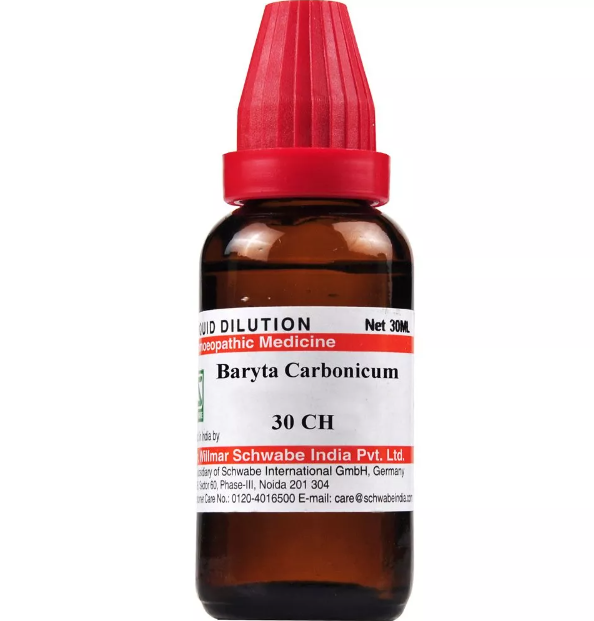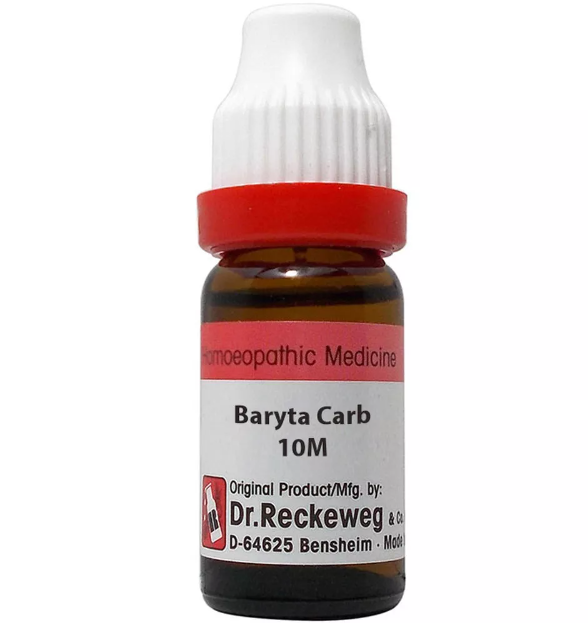BARYTA CARBONICA 6C, 12C, 30C, 200C, 1M, 10M USES AND SYMPTOMS
 BARYTA CARBONICA
BARYTA CARBONICA
(Carbonate of Baryta)
Bar-c.
Especially suited for infants and the elderly. This remedy assists scrofulous children, particularly those who are mentally and physically underdeveloped, stunted in growth, and have scrofulous eye inflammation, a swollen abdomen, susceptibility to colds, and always swollen tonsils. It is beneficial for those prone to quinsy with a tendency to suppuration; their gums bleed easily. In old age, it addresses degenerative changes, particularly in the heart, blood vessels, and brain, often accompanied by a hypertrophied prostate or hardened testes, extreme sensitivity to cold, offensive foot sweats, and profound weakness necessitating support when standing. There is a strong aversion to meeting strangers. It affects glandular structures, aiding in general degenerative changes, especially in arterial walls, aneurysms, and senility. Bar-c. acts as a cardiovascular toxin, affecting the muscular layers of the heart and blood vessels, leading to arterial fibrosis, softening, and degeneration, predisposing to aneurysms and strokes.
Mind: Memory loss, mental weakness, indecisiveness, loss of self-confidence, senile dementia, confusion, bashfulness, aversion to strangers, and childish behavior with undue grief over trivial matters.
Head: Vertigo aggravated by standing in the sun, with a sensation of stitches extending through the head, loose feeling in the brain, hair loss, confusion, and the presence of wens.
Eyes: Alternating dilation and contraction of pupils, photophobia, sensation of gauze before the eyes, cataracts.
Ears: Hardness of hearing, crackling noise, painful and swollen glands around the ears, reverberation on blowing the nose.
Nose: Dryness, sneezing, coryza with swelling of upper lip and nose, sensation of smoke in the nose, discharge of thick, yellow mucus, frequent epistaxis, scabs around the nostrils.
Face: Pale, puffy, sensation of a cobweb, swelling of the upper lip.
Mouth: Dry mouth upon waking, bleeding and receding gums, stomatitis with inflamed vesicles, foul taste, paralysis of the tongue, burning pain on the tip of the tongue, dribbling of saliva at dawn, esophageal spasms on swallowing.
Throat: Swollen submaxillary glands and tonsils, easy susceptibility to colds with stitching and smarting pain, quinsy, suppurating tonsils after every cold, inflamed tonsils with swollen veins, smarting pain on swallowing, sensation of a plug in the throat, difficulty swallowing solids, spasm of the esophagus causing gagging and choking, stinging pain in tonsils, pharynx, or larynx.
Stomach: Waterbrash, hiccoughs, eructation relieving pressure, hunger with food refusal, postprandial epigastric pain and tenderness, worsened by warm food, gastric weakness in the elderly possibly indicating malignancy.
Abdomen: Hard, tense, and distended abdomen, colic, enlarged mesenteric glands, abdominal pain on swallowing food, habitual colic with hunger but refusal to eat.
Rectum: Constipation with hard, knotty stools, hemorrhoids protruding during urination, crawling sensation in rectum, anal oozing.
Urinary: Piles protrude with each urination, urging to urinate, burning in urethra during urination.
Male: Reduced desire and premature impotence, enlarged prostate, indurated testicles.
Female: Premenstrual stomach and lumbosacral pain, scanty menses.
Respiratory: Dry, suffocative cough in the elderly, rich in mucus but lacking expectoration strength, worsened by weather changes, sensation of inhaling smoke, chronic aphonia, chest stitches worse on inspiration, feeling of lungs filled with smoke.
Heart: Palpitations and discomfort in the cardiac region, aneurysms, increased heart rate and blood pressure initially, followed by vessel contraction, palpitations when lying on the left side, especially when thinking of it, full and hard pulse, cardiac symptoms following suppressed foot sweat.
Back: Swollen glands in the nape of the neck, fatty tumors around the neck, bruised pain between the shoulder blades, sacral stiffness, weakness in the spine.
Extremities: Pain in axillary glands, cold and clammy feet, fetid foot sweats, numbness of limbs, numbness from knees to scrotum relieved by sitting, sore toes and soles, painful soles when walking, joint pain, burning pain in lower limbs.
Sleep: Talking in sleep, frequent waking, feeling excessively hot, twitching during sleep.
Modalities: Symptoms worsen with contemplation, washing, lying on the painful side; improve with outdoor walking.
Relationship: Comparable to Dig., Rad-br., Arag., Oxyt., Astrag. Complementary to Dulc., Sil., Psor. Incompatible with Calc. Antidote for toxic doses: Epsom salts. Dose: Third to thirtieth potency; the latter removes predisposition to quinsy. Bar-c. acts slowly and may require repeated dosing.
SYMPTOMS OF BARYTA CARBONICA
Infants and old age.
Scrofulous children, mentally and physically backward, dwarfish, with scrofulous ophthalmia, swollen abdomen, swollen tonsils, and easy susceptibility to colds.
Tendency to quinsy, bleeding gums.
Degenerative changes in old age, especially cardiac, vascular, cerebral.
Hypertrophied prostate or indurated testes.
Very sensitive to cold, offensive foot sweats, weakness.
Aversion to strangers, childishness.
Mind:
Loss of memory, mental weakness.
Irresolute, lacking confidence.
Senile dementia, confusion.
Bashful, avoids strangers.
Childish behavior, easily upset by trifles.
Head:
Vertigo aggravated in the sun.
Loose sensation in the brain.
Hair loss, confusion, wens (cysts).
Eyes:
Alternating dilation and contraction of pupils.
Sensitivity to light, vision obscured by a gauze-like appearance.
Cataracts.
Ears:
Hearing loss, crackling noises.
Painful, swollen glands around the ears.
Nose:
Dryness, sneezing, swollen upper lip.
Sensation of smoke, thick yellow mucus, frequent nosebleeds.
Scabs around the nostrils.
Face:
Pale, puffy face, sensation of cobwebs.
Swollen upper lip.
Mouth:
Dry mouth on waking, bleeding gums.
Inflamed mouth with foul taste, vesicles, tongue paralysis.
Saliva dribbles at dawn, esophageal spasms.
Throat:
Swollen tonsils, glands; prone to quinsy.
Painful swallowing, sensation of a plug.
Spasms, choking on swallowing.
Stomach:
Waterbrash, hiccups, eructations.
Hunger but refusal of food.
Post-meal pain, epigastric tenderness.
Abdomen:
Hard, distended abdomen, colicky pain.
Enlarged mesenteric glands.
Rectum:
Constipation, hemorrhoids.
Rectal crawling, anal oozing.
Urinary:
Piles protrude with urination, urinary urgency, urethral burning.
Male:
Decreased libido, enlarged prostate, indurated testes.
Female:
Premenstrual pain, scanty menses.
Respiratory:
Dry, suffocative cough in old age.
Laryngeal smoke sensation, chronic aphonia.
Chest pain worse on inspiration.
Heart:
Palpitations, distress.
Aneurysm, increased blood pressure.
Palpitations on left side lying down.
Back:
Swollen nape glands, fatty tumors.
Bruised pain, sacral stiffness, spinal weakness.
Extremities:
Pain in axillary glands, cold, clammy feet.
Fetid foot sweats, numbness, joint pain.
Sleep:
Talking, frequent waking, overheated feeling, twitching.
Modalities:
Worse from thinking of symptoms, washing, lying on painful side.
Better from walking in open air.
Relationships:
Similar to Dig., Rad-br., Arag., Oxyt., Astrag.
Complementary to Dulc., Sil., Psor.
Incompatible with Calc.
Antidote: Epsom salts.
Dosage: 3X to 30X potency; higher potency removes quinsy predisposition. Slow-acting, may require repetition.
selection of the potency
Individualization:
- Homeopathy is based on the principle of treating the individual, not just the disease. The unique symptoms and characteristics of the person are crucial in determining the most suitable potency.
Intensity of Symptoms:
- The intensity of the symptoms guides the choice of potency. If the symptoms are intense and acute, a lower potency (e.g., 6C, 30C) might be considered. For chronic conditions with less intensity, higher potencies (e.g., 200C, 1M) may be appropriate.
Sensitivity of the Patient:
- Some individuals are more sensitive to homeopathic remedies, while others may require higher potencies. The practitioner considers the patient’s sensitivity when selecting the potency.
Acute vs. Chronic Conditions:
- Lower potencies are often used for acute conditions, while higher potencies may be considered for chronic or long-standing issues.
Previous Response to Potencies:
- The patient’s response to previous homeopathic treatments helps guide the choice of potency. If a particular potency has been effective in the past, it may be repeated or adjusted as needed.
Vital Force and Susceptibility:
- Homeopathy views illness as a disturbance in the vital force. The practitioner assesses the patient’s overall vitality and susceptibility to determine the appropriate potency.
Aggravation or Amelioration:
- The direction of the symptom response (aggravation or amelioration) after taking a remedy can influence the choice of potency.
Miasmatic Considerations:
- In classical homeopathy, the concept of miasms (inherited disease tendencies) is considered. The practitioner take this into account when selecting the potency.
Practitioner Experience:
- The experience and preference of the homeopathic practitioner play a role. Some practitioners may have success with certain potencies based on their clinical experience.
SAFETY INFORMATION
- Do not exceed the recommended dose by physician
- Keep out of the reach of children
- Store in a cool dry place away from direct sunlight
- Maintain half an hour gap between food/drink/any other medicines and homoeopathic medicine
- Avoid any strong smell in the mouth while taking medicine e.g. camphor, garlic, onion, coffee, hing
Medicine images use for reference only selection of homeopathic medicine depends on the individual’s specific symptoms and overall constitution. Moreover, homeopathy is a holistic system of medicine that treats the individual as a whole. In addition to addressing the physical symptoms, it takes into account the emotional and mental state of the person. Consequently, it’s crucial to consult with a qualified homeopathic practitioner for personalized treatment.
The information provided on this website is intended solely for educational purposes. Always seek the advice of your physician or other qualified health provider.
